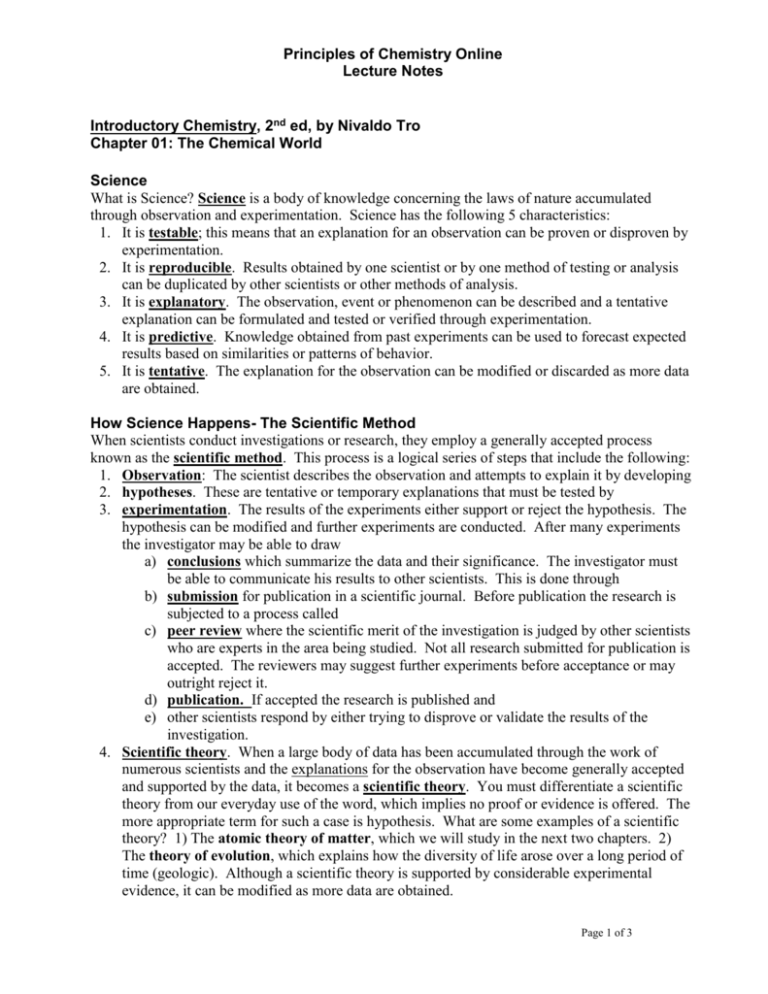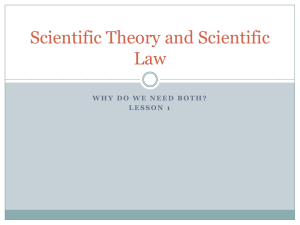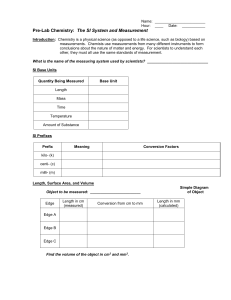Chapter 01 Lecture Notes - Tutor
advertisement

Principles of Chemistry Online Lecture Notes Introductory Chemistry, 2nd ed, by Nivaldo Tro Chapter 01: The Chemical World Science What is Science? Science is a body of knowledge concerning the laws of nature accumulated through observation and experimentation. Science has the following 5 characteristics: 1. It is testable; this means that an explanation for an observation can be proven or disproven by experimentation. 2. It is reproducible. Results obtained by one scientist or by one method of testing or analysis can be duplicated by other scientists or other methods of analysis. 3. It is explanatory. The observation, event or phenomenon can be described and a tentative explanation can be formulated and tested or verified through experimentation. 4. It is predictive. Knowledge obtained from past experiments can be used to forecast expected results based on similarities or patterns of behavior. 5. It is tentative. The explanation for the observation can be modified or discarded as more data are obtained. How Science Happens- The Scientific Method When scientists conduct investigations or research, they employ a generally accepted process known as the scientific method. This process is a logical series of steps that include the following: 1. Observation: The scientist describes the observation and attempts to explain it by developing 2. hypotheses. These are tentative or temporary explanations that must be tested by 3. experimentation. The results of the experiments either support or reject the hypothesis. The hypothesis can be modified and further experiments are conducted. After many experiments the investigator may be able to draw a) conclusions which summarize the data and their significance. The investigator must be able to communicate his results to other scientists. This is done through b) submission for publication in a scientific journal. Before publication the research is subjected to a process called c) peer review where the scientific merit of the investigation is judged by other scientists who are experts in the area being studied. Not all research submitted for publication is accepted. The reviewers may suggest further experiments before acceptance or may outright reject it. d) publication. If accepted the research is published and e) other scientists respond by either trying to disprove or validate the results of the investigation. 4. Scientific theory. When a large body of data has been accumulated through the work of numerous scientists and the explanations for the observation have become generally accepted and supported by the data, it becomes a scientific theory. You must differentiate a scientific theory from our everyday use of the word, which implies no proof or evidence is offered. The more appropriate term for such a case is hypothesis. What are some examples of a scientific theory? 1) The atomic theory of matter, which we will study in the next two chapters. 2) The theory of evolution, which explains how the diversity of life arose over a long period of time (geologic). Although a scientific theory is supported by considerable experimental evidence, it can be modified as more data are obtained. Page 1 of 3 5. Scientific law. You must also differentiate a scientific law from a scientific theory. A scientific law is a brief statement or mathematical equation summarizing a large body of data or observation or phenomenon. Some examples are the law of conservation of mass, which states that “matter is neither created nor destroyed in chemical reactions” and Boyle’s law, which states that “the volume of an ideal gas decreases as pressure is increased if the amount of gas and the temperature are held constant.” A scientific law describes an observation that is universally true under the specified conditions. Chemistry We will now turn our attention to chemistry a branch of science concerned with the study of matter and the changes it undergoes. Matter is anything that has mass and occupies space; it is the physical material of the universe. Everything in the universe is composed of matter. Furthermore, all matter is composed of atoms and molecules, which we will study in more detail as we progress through this course. Chemists try to understand how the universe and everything in it works on a large scale by studying how the atoms and molecules interact with each other on a submicroscopic scale. Succeeding in Chemistry Be curious! Chemistry is not obscure- you do chemistry every day and your very life depends on it every single day! Ask lots of questions- especially why and how! In this class, use the discussion board on the Blackboard course site to ask questions about anything you might not understand from your reading. Most especially, ask the questions you might think would be “dumb”- these are usually the ones to which your classmates want answers also and they will appreciate your boldness in asking (as will your instructors!) Notice the details! What do you see, hear, smell or feel as you are doing your labs? What are the units of the numbers you use to solve your homework problems? How good are the numbers? Work at solving problems- as with becoming a good athlete or a good musician, problem-solving takes a lot of practice! Don’t just read the example problems in the book- work along with the author in solving the problem. Be sure you ask someone if you don’t understand how the author gets from one step to the next. Commit to working on chemistry at least an hour or two every day- or at least on the days that you eat! You will be much more successful if you take the material in small bites and take time to digest it, rather than rushing through several chapters because the assignment is due in a half hour! Workflow: Working through the material in this course will definitely take up a chunk of your time. We suggest that you begin by reading through the chapters that are assigned for the week, taking your own notes in a notebook as you go. Highlighting points in your text works for some people, but for most, the act of writing out definitions and concepts is important in really understanding them and committing them to memory. One method of note-taking is called the Cornell method. In this method, you divide your notebook page by drawing a line down the page so that the left column takes up approximately one-third of the page and the right column takes up the remaining two thirds. Put a vocabulary word or concept in the left column and put the related definition or details on the right side of the page. This way as you review, you don’t have to read all the details every time and a glance at the left Page 2 of 3 column will jog your memory as to what is important Once you have read over the chapters, view the powerpoint slides, and read over the lecture notes. Then begin the homework problems. Remember that the discussion board is available at any point along the way, to get clarification on specific points or help with problems. It pays to be specific about what you don’t understand in asking questions on the discussion board. If you can help answer another student’s questions, that is a good thing also. Explaining something to someone else is the very best way to learn it. Your instructor keeps a good eye on the discussion board to make sure no one is led astray! Finally, be aware that it is your responsibility to ask for help when you need it. If you need assistance with something beyond the scope of the discussion board, consult with your instructor by phone or by email. Don’t flounder along until the exam, expecting things to take care of themselves. They won’t! Please be aware that although some online courses have a reputation for being “easy,” this is not one of those courses. You will work hard in this course. However, we believe that most students have the ability to be successful in this course, if you follow our suggestions and study tips. You must take responsibility for your own success, but remember that you are not alone- we are here to help and guide you! Page 3 of 3







